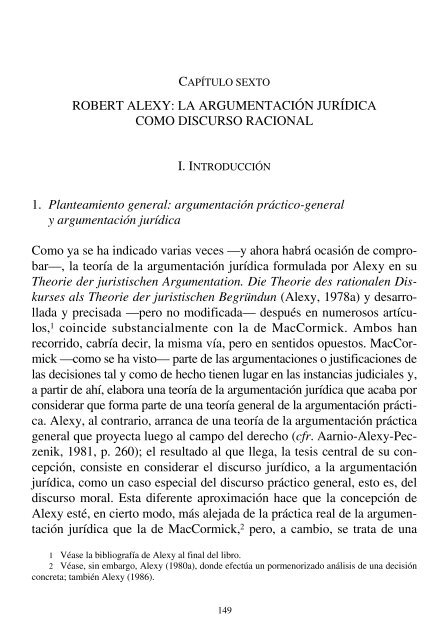LAS RAZONES DEL DERECHO Teo rías de la ar gu men ta ción ju rí di ca
You also want an ePaper? Increase the reach of your titles
YUMPU automatically turns print PDFs into web optimized ePapers that Google loves.
CAPÍTULO SEXTO<br />
ROBERT ALEXY: LA ARGUMENTACIÓN JURÍDICA<br />
COMO DISCURSO RACIONAL<br />
I. INTRODUCCIÓN<br />
1. P<strong>la</strong>nteamiento general: <strong>ar</strong><strong>gu</strong><strong>men</strong><strong>ta</strong><strong>ción</strong> práctico-general<br />
y <strong>ar</strong><strong>gu</strong><strong>men</strong><strong>ta</strong><strong>ción</strong> <strong>ju</strong><strong>rí</strong><strong>di</strong><strong>ca</strong><br />
Como ya se ha in<strong>di</strong><strong>ca</strong>do v<strong>ar</strong>ias veces —y ahora habrá o<strong>ca</strong>sión <strong>de</strong> comprob<strong>ar</strong>—,<br />
<strong>la</strong> teo<strong>rí</strong>a <strong>de</strong> <strong>la</strong> <strong>ar</strong><strong>gu</strong><strong>men</strong><strong>ta</strong><strong>ción</strong> <strong>ju</strong><strong>rí</strong><strong>di</strong><strong>ca</strong> formu<strong>la</strong>da por Alexy en su<br />
Theorie <strong>de</strong>r <strong>ju</strong>ristischen Ar<strong>gu</strong><strong>men</strong><strong>ta</strong>tion. Die Theorie <strong>de</strong>s rationalen Diskurses<br />
als Theorie <strong>de</strong>r <strong>ju</strong>ristischen Begründun (Alexy, 1978a) y <strong>de</strong>s<strong>ar</strong>rol<strong>la</strong>da<br />
y precisada —pero no mo<strong>di</strong>fi<strong>ca</strong>da— <strong>de</strong>spués en numerosos <strong>ar</strong>tículos,<br />
1 coinci<strong>de</strong> subs<strong>ta</strong>ncial<strong>men</strong>te con <strong>la</strong> <strong>de</strong> MacCormick. Ambos han<br />
recorrido, <strong>ca</strong>b<strong>rí</strong>a <strong>de</strong>cir, <strong>la</strong> misma vía, pero en sentidos opuestos. MacCormick<br />
—como se ha visto— p<strong>ar</strong>te <strong>de</strong> <strong>la</strong>s <strong>ar</strong><strong>gu</strong><strong>men</strong><strong>ta</strong>ciones o <strong>ju</strong>stifi<strong>ca</strong>ciones <strong>de</strong><br />
<strong>la</strong>s <strong>de</strong>cisiones <strong>ta</strong>l y como <strong>de</strong> hecho tienen lug<strong>ar</strong> en <strong>la</strong>s ins<strong>ta</strong>ncias <strong>ju</strong><strong>di</strong>ciales y,<br />
a p<strong>ar</strong>tir <strong>de</strong> ahí, e<strong>la</strong>bora una teo<strong>rí</strong>a <strong>de</strong> <strong>la</strong> <strong>ar</strong><strong>gu</strong><strong>men</strong><strong>ta</strong><strong>ción</strong> <strong>ju</strong><strong>rí</strong><strong>di</strong><strong>ca</strong> que a<strong>ca</strong>ba por<br />
consi<strong>de</strong>r<strong>ar</strong> que forma p<strong>ar</strong>te <strong>de</strong> una teo<strong>rí</strong>a general <strong>de</strong> <strong>la</strong> <strong>ar</strong><strong>gu</strong><strong>men</strong><strong>ta</strong><strong>ción</strong> prácti<strong>ca</strong>.<br />
Alexy, al contr<strong>ar</strong>io, <strong>ar</strong>ran<strong>ca</strong> <strong>de</strong> una teo<strong>rí</strong>a <strong>de</strong> <strong>la</strong> <strong>ar</strong><strong>gu</strong><strong>men</strong><strong>ta</strong><strong>ción</strong> prácti<strong>ca</strong><br />
general que proyec<strong>ta</strong> luego al <strong>ca</strong>mpo <strong>de</strong>l <strong>de</strong>recho (cfr. A<strong>ar</strong>nio-Alexy-Peczenik,<br />
1981, p. 260); el resul<strong>ta</strong>do al que llega, <strong>la</strong> tesis central <strong>de</strong> su concep<strong>ción</strong>,<br />
consiste en consi<strong>de</strong>r<strong>ar</strong> el <strong>di</strong>scurso <strong>ju</strong><strong>rí</strong><strong>di</strong>co, a <strong>la</strong> <strong>ar</strong><strong>gu</strong><strong>men</strong><strong>ta</strong><strong>ción</strong><br />
<strong>ju</strong><strong>rí</strong><strong>di</strong><strong>ca</strong>, como un <strong>ca</strong>so especial <strong>de</strong>l <strong>di</strong>scurso práctico general, esto es, <strong>de</strong>l<br />
<strong>di</strong>scurso moral. Es<strong>ta</strong> <strong>di</strong>ferente aproxima<strong>ción</strong> hace que <strong>la</strong> concep<strong>ción</strong> <strong>de</strong><br />
Alexy esté, en cierto modo, más alejada <strong>de</strong> <strong>la</strong> prácti<strong>ca</strong> real <strong>de</strong> <strong>la</strong> <strong>ar</strong><strong>gu</strong><strong>men</strong><strong>ta</strong><strong>ción</strong><br />
<strong>ju</strong><strong>rí</strong><strong>di</strong><strong>ca</strong> que <strong>la</strong> <strong>de</strong> MacCormick, 2 pero, a <strong>ca</strong>mbio, se tra<strong>ta</strong> <strong>de</strong> una<br />
1 Véase <strong>la</strong> bibliografía <strong>de</strong> Alexy al final <strong>de</strong>l libro.<br />
2 Véase, sin emb<strong>ar</strong>go, Alexy (1980a), don<strong>de</strong> efectúa un por<strong>men</strong>orizado análisis <strong>de</strong> una <strong>de</strong>cisión<br />
concre<strong>ta</strong>; <strong>ta</strong>mbién Alexy (1986).<br />
149



